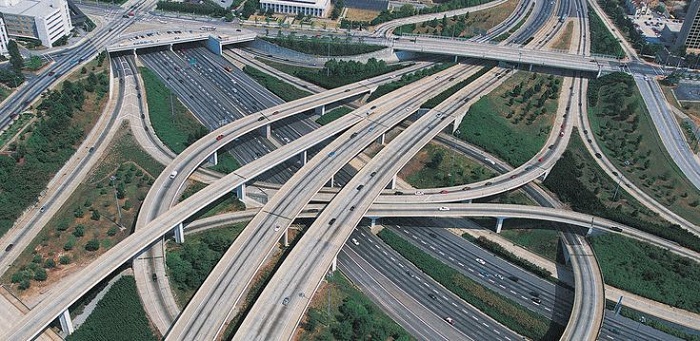Road linings, often understated yet integral, are the markings that help define the structure and functionality of transportation networks. Found on highways, local streets, parking lots, and industrial areas, these markings are vital for ensuring safety, managing traffic flow, and communicating essential information to drivers, cyclists, and pedestrians.
In this article, we’ll dive into the significance of road linings, how they are applied, the materials used, and the critical role they play in maintaining orderly and efficient roadways.
What Are Road Linings?
Road linings, also called road markings, are strategically applied patterns, symbols, and lines that communicate information to road users. These markings serve as visual cues, guiding movements, defining spaces, and highlighting hazards.
The purpose of road linings extends beyond aesthetics. They enforce traffic laws, organise transportation, and create a safer environment for all.
Key Functions of Road Linings
1. Traffic Guidance
Road linings define lanes, indicate turning zones, and mark the edges of the roadway. They are indispensable for managing high-density traffic and ensuring drivers navigate correctly.
2. Enhanced Road Safety
By making intersections, crossings, and danger zones visible, road linings reduce the likelihood of accidents and promote smoother traffic operations.
3. Space Organisation
In areas like parking lots and loading zones, road linings help designate specific spaces, optimising usability and compliance with regulations.
4. Hazard Warnings
Road linings can highlight dangers such as sharp turns, construction zones, or reduced speed areas, ensuring drivers are alerted in advance.
5. Promoting Accessibility
Dedicated markings for bicycles, pedestrians, and disabled access ensure inclusivity and support the diverse needs of modern road users.
Types of Road Linings
Road linings come in various forms, each tailored to specific needs:
1. Continuous and Broken Lines
These lines separate traffic lanes, indicate overtaking rules, and outline road edges.
2. Crossings and Stop Lines
Zebra crossings, pedestrian zones, and stop lines manage intersections and prioritise foot traffic.
3. Directional Arrows
Arrows direct vehicles into proper lanes for turns, exits, or merging, preventing confusion and congestion.
4. Parking and Reserved Spaces
Markings in parking lots guide drivers to designated areas, improving organisation and compliance.
5. Hatching and Chevrons
Diagonal and patterned markings signal restricted areas or lane divisions, increasing awareness of specific conditions.
Materials Used in Road Linings
Modern road linings utilise durable, high-performance materials to withstand the demands of weather and traffic:
1. Thermoplastic
Known for its longevity, thermoplastic is heated and applied as a liquid, forming a tough and reflective surface. It’s ideal for high-traffic roads.
2. Road Marking Paint
Paint is a cost-effective solution for less demanding environments, offering flexibility for temporary or low-traffic areas.
3. Cold Plastic
A durable option that doesn’t require heating, cold plastic is commonly used in areas with heavy vehicle loads.
4. Reflective Additives
Glass beads or reflective materials are often embedded into markings to enhance visibility in low-light or adverse weather conditions.
The Application Process
Applying road linings involves a series of precise steps to ensure effectiveness and longevity:
1. Site Survey
The process begins with assessing the area, identifying the specific markings needed, and planning their placement for optimal impact.
2. Surface Preparation
The surface is cleaned thoroughly to remove dirt, oil, and debris. This ensures strong adhesion and a smooth finish.
3. Marking Layout
Guidelines or stencils are set up to map out the markings, ensuring accuracy during application.
4. Application of Markings
Specialised machinery is used to apply the chosen material. Depending on the type, this may involve heating or layering for durability.
5. Final Inspection
Once the markings are cured, they are inspected for clarity, visibility, and adherence to regulations.
Why Are Road Linings Essential?
1. Ensuring Road Safety
Clear markings minimise confusion and help drivers, pedestrians, and cyclists navigate with confidence, reducing the risk of accidents.
2. Supporting Traffic Management
Road linings organise traffic flow, improving efficiency and reducing congestion, especially in busy urban areas.
3. Enhancing Compliance
Markings ensure adherence to local and national traffic laws, contributing to a well-regulated transport system.
4. Aesthetic and Functional Improvements
Well-maintained road markings enhance the overall appearance of a roadway while ensuring its practicality.
5. Environmentally Friendly Infrastructure
Sustainable road linings, particularly those using recyclable materials, align with modern eco-friendly goals for urban development.
Common Issues Addressed by Road Linings
1. Faded Markings
Over time, road linings can fade, reducing visibility and effectiveness. Regular maintenance ensures they remain clear and functional.
2. Changing Traffic Needs
As traffic patterns evolve, updates to road linings accommodate new requirements, such as additional lanes or reconfigured intersections.
3. Weather-Related Wear
Exposure to rain, snow, and UV rays can deteriorate markings. Choosing the right materials helps mitigate these effects.
4. Increased Traffic Loads
Heavy vehicles and frequent use can wear down markings in high-traffic zones. Durable materials like thermoplastic are particularly effective here.
Road lining service Norfolk are indispensable for creating safe, efficient, and organised transportation systems. From guiding vehicles to ensuring accessibility and warning of hazards, these markings play a pivotal role in everyday travel.
With their ability to enhance safety, manage traffic flow, and improve the functionality of public and private spaces, road linings are a vital component of modern infrastructure. Investing in high-quality materials and regular maintenance ensures they continue to serve their purpose effectively, supporting the evolving needs of today’s road users.
Road linings, often understated yet integral, are the markings that help define the structure and functionality of transportation networks. Found on highways, local streets, parking lots, and industrial areas, these markings are vital for ensuring safety, managing traffic flow, and communicating essential information to drivers, cyclists, and pedestrians.
In this article, we’ll dive into the significance of road linings, how they are applied, the materials used, and the critical role they play in maintaining orderly and efficient roadways.
What Are Road Linings?
Road linings, also called road markings, are strategically applied patterns, symbols, and lines that communicate information to road users. These markings serve as visual cues, guiding movements, defining spaces, and highlighting hazards.
The purpose of road linings extends beyond aesthetics. They enforce traffic laws, organise transportation, and create a safer environment for all.
Key Functions of Road Linings
1. Traffic Guidance
Road linings define lanes, indicate turning zones, and mark the edges of the roadway. They are indispensable for managing high-density traffic and ensuring drivers navigate correctly.
2. Enhanced Road Safety
By making intersections, crossings, and danger zones visible, road linings reduce the likelihood of accidents and promote smoother traffic operations.
3. Space Organisation
In areas like parking lots and loading zones, road linings help designate specific spaces, optimising usability and compliance with regulations.
4. Hazard Warnings
Road linings can highlight dangers such as sharp turns, construction zones, or reduced speed areas, ensuring drivers are alerted in advance.
5. Promoting Accessibility
Dedicated markings for bicycles, pedestrians, and disabled access ensure inclusivity and support the diverse needs of modern road users.
Types of Road Linings
Road linings come in various forms, each tailored to specific needs:
1. Continuous and Broken Lines
These lines separate traffic lanes, indicate overtaking rules, and outline road edges.
2. Crossings and Stop Lines
Zebra crossings, pedestrian zones, and stop lines manage intersections and prioritise foot traffic.
3. Directional Arrows
Arrows direct vehicles into proper lanes for turns, exits, or merging, preventing confusion and congestion.
4. Parking and Reserved Spaces
Markings in parking lots guide drivers to designated areas, improving organisation and compliance.
5. Hatching and Chevrons
Diagonal and patterned markings signal restricted areas or lane divisions, increasing awareness of specific conditions.
Materials Used in Road Linings
Modern road linings utilise durable, high-performance materials to withstand the demands of weather and traffic:
1. Thermoplastic
Known for its longevity, thermoplastic is heated and applied as a liquid, forming a tough and reflective surface. It’s ideal for high-traffic roads.
2. Road Marking Paint
Paint is a cost-effective solution for less demanding environments, offering flexibility for temporary or low-traffic areas.
3. Cold Plastic
A durable option that doesn’t require heating, cold plastic is commonly used in areas with heavy vehicle loads.
4. Reflective Additives
Glass beads or reflective materials are often embedded into markings to enhance visibility in low-light or adverse weather conditions.
The Application Process
Applying road linings involves a series of precise steps to ensure effectiveness and longevity:
1. Site Survey
The process begins with assessing the area, identifying the specific markings needed, and planning their placement for optimal impact.
2. Surface Preparation
The surface is cleaned thoroughly to remove dirt, oil, and debris. This ensures strong adhesion and a smooth finish.
3. Marking Layout
Guidelines or stencils are set up to map out the markings, ensuring accuracy during application.
4. Application of Markings
Specialised machinery is used to apply the chosen material. Depending on the type, this may involve heating or layering for durability.
5. Final Inspection
Once the markings are cured, they are inspected for clarity, visibility, and adherence to regulations.
Why Are Road Linings Essential?
1. Ensuring Road Safety
Clear markings minimise confusion and help drivers, pedestrians, and cyclists navigate with confidence, reducing the risk of accidents.
2. Supporting Traffic Management
Road linings organise traffic flow, improving efficiency and reducing congestion, especially in busy urban areas.
3. Enhancing Compliance
Markings ensure adherence to local and national traffic laws, contributing to a well-regulated transport system.
4. Aesthetic and Functional Improvements
Well-maintained road markings enhance the overall appearance of a roadway while ensuring its practicality.
5. Environmentally Friendly Infrastructure
Sustainable road linings, particularly those using recyclable materials, align with modern eco-friendly goals for urban development.
Common Issues Addressed by Road Linings
1. Faded Markings
Over time, road linings can fade, reducing visibility and effectiveness. Regular maintenance ensures they remain clear and functional.
2. Changing Traffic Needs
As traffic patterns evolve, updates to road linings accommodate new requirements, such as additional lanes or reconfigured intersections.
3. Weather-Related Wear
Exposure to rain, snow, and UV rays can deteriorate markings. Choosing the right materials helps mitigate these effects.
4. Increased Traffic Loads
Heavy vehicles and frequent use can wear down markings in high-traffic zones. Durable materials like thermoplastic are particularly effective here.
Road lining service Norfolk are indispensable for creating safe, efficient, and organised transportation systems. From guiding vehicles to ensuring accessibility and warning of hazards, these markings play a pivotal role in everyday travel.
With their ability to enhance safety, manage traffic flow, and improve the functionality of public and private spaces, road linings are a vital component of modern infrastructure. Investing in high-quality materials and regular maintenance ensures they continue to serve their purpose effectively, supporting the evolving needs of today’s road users.










Leave a Reply